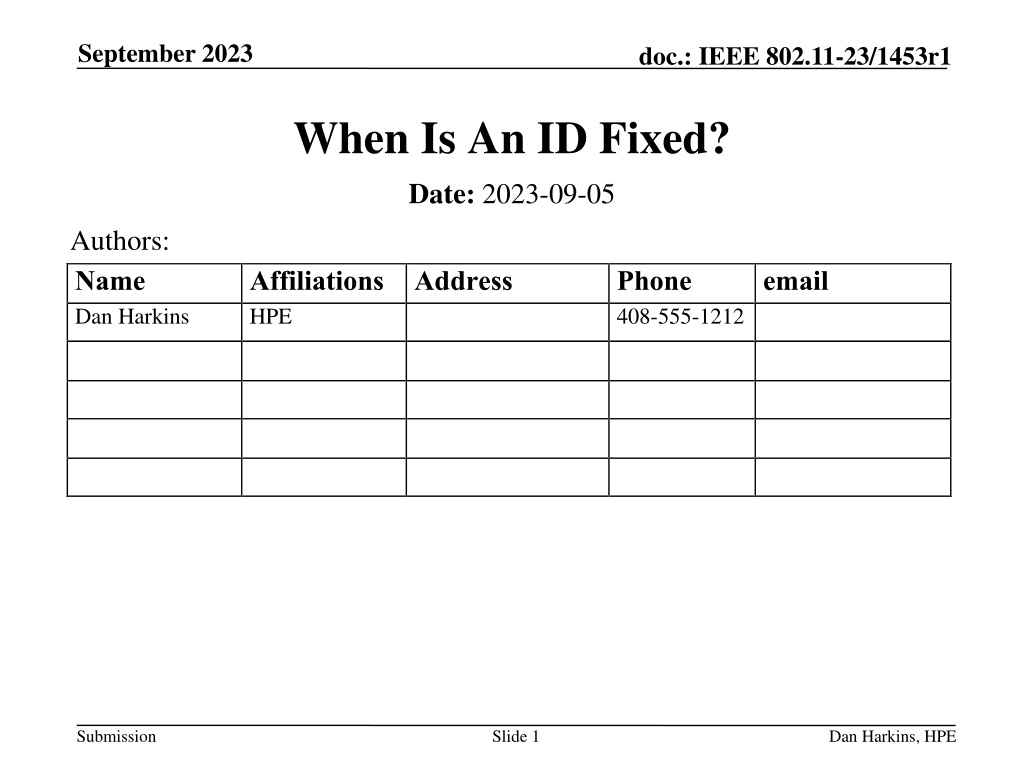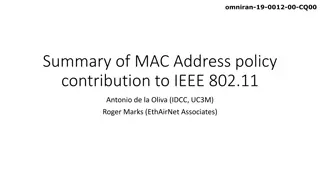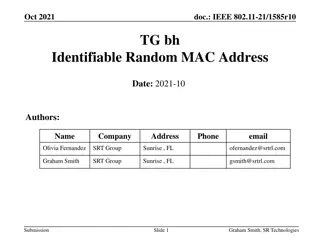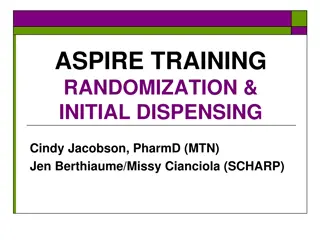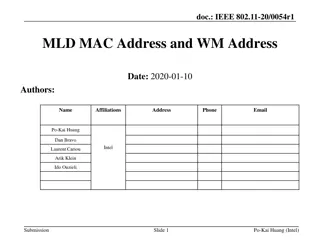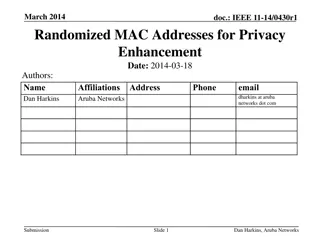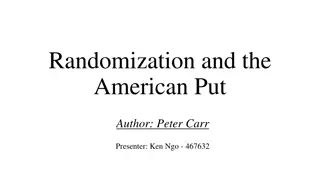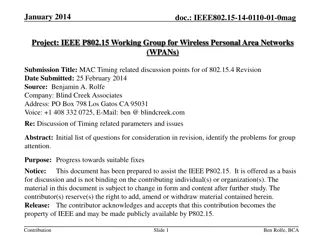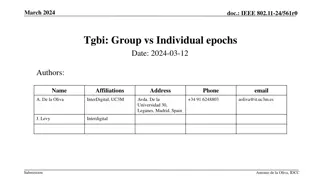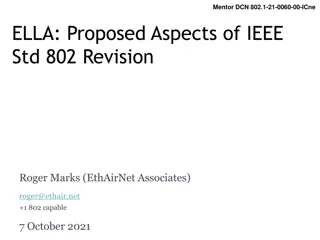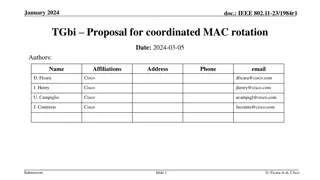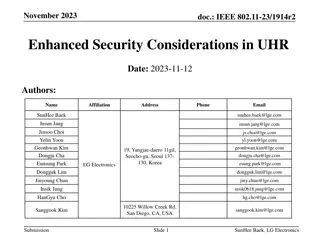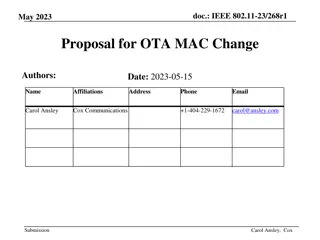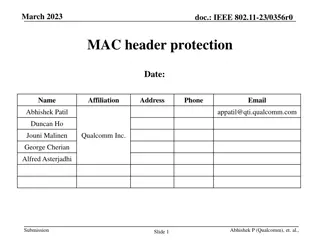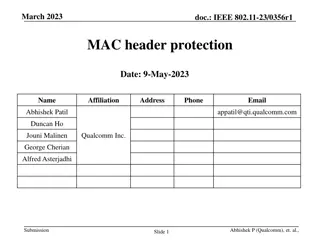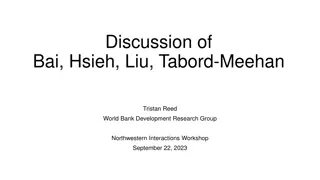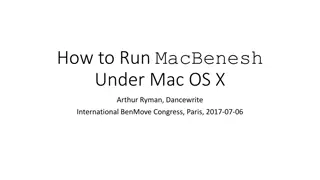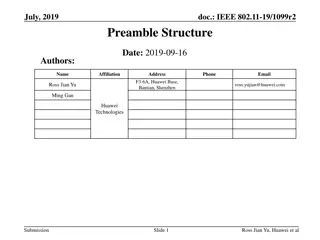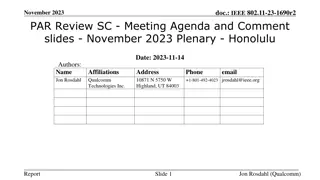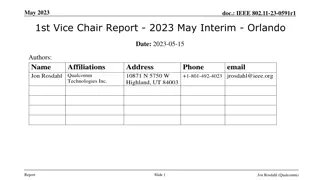Implications of IEEE 802.11 State Machine and MAC Randomization
The document discusses the state machine transitions in IEEE 802.11, focusing on MAC address handling and implications for STA connectivity within an ESS. It explains the scenarios where a STA can use different MAC addresses, emphasizing the binding of state to specific address configurations and the flexibility for privacy concerns.
Download Presentation

Please find below an Image/Link to download the presentation.
The content on the website is provided AS IS for your information and personal use only. It may not be sold, licensed, or shared on other websites without obtaining consent from the author. Download presentation by click this link. If you encounter any issues during the download, it is possible that the publisher has removed the file from their server.
E N D
Presentation Transcript
September 2023 doc.: IEEE 802.11-23/1453r1 When Is An ID Fixed? Date: 2023-09-05 Authors: Name Dan Harkins Affiliations Address HPE Phone 408-555-1212 email Submission Slide 1 Dan Harkins, HPE
September 2023 doc.: IEEE 802.11-23/1453r1 Abstract Discussion and a couple straw polls Submission Slide 2 Dan Harkins, HPE
September 2023 doc.: IEEE 802.11-23/1453r1 802.11 State Machine In State 1 the STA is neither 802.11 authenticated nor associated MAC address is not fixed In State 2 the STA has chosen an AP through 802.11 authentication, this choice is not exclusive BUT if it wishes to advance this state to State 3 it shall use the MAC address from State 2 to do so A STA can be 802.11 authenticated with multiple APs in an ESS but associated to only one In State 3 the STA has exclusively chosen an AP with which to associate, the MAC address used here is identical to that from State 2 for this state machine Entrance to State 4 establishes more state in the state machine, the MAC address used here is identical to that from State 3 for this state machine Submission Slide 3 Dan Harkins, HPE
September 2023 doc.: IEEE 802.11-23/1453r1 802.11 on Random MAC Addresses (emphasis mine) 12.2.10 Requirements for support of MAC privacy enhancements However, the non-AP STA shall not change its MAC address during a transactional exchange, for example, transmitting Public Action frames for preassociation discovery, or during the creation of state on an AP using preassociation capabilities, for example, RSN preauthentication or FT over-the- DS . If such a non-AP STA starts any transaction that establishes state bound to a MAC address and might elect to establish an association or establish transaction state with a discovered BSS, it shall check the value of dot11LocallyAdministeredMACConfig and shall configure its MAC address according to the rules of the local address space prior to the start of the transaction. State created with an AP using a prior MAC address, for instance, RSN preauthentication state or FT state established over- the-DS, is bound to the MAC address used when that state was created. Prior to establishing an association to the AP, the non-AP STA shall change its MAC address to the MAC address used when the state was created. Important Note: A STA can choose a different MAC address when establishing new connectivity in an ESS if it is not using state established in the ESS with an older MAC address to establish that new connectivity. There is nothing in the standard against a STA opting out of this requirement in the interest of privacy. In other words, a STA does not have to use the same MAC address in an ESS as long as it s willing to throw away all its state every time it connects. Submission Slide 4 Dan Harkins, HPE
September 2023 doc.: IEEE 802.11-23/1453r1 Implications of 802.11 State Machine Transitions and MAC Randomization A STA can have state machines with different APs active using different MAC addresses in an ESS provided that there is only one state machine in State 2. Once shared state is created that state is bound to that state machine and the MAC address that created it. The STA can use a different MAC when connected to the ESS using a different state machine-- i.e. associate to the ESS using a different MAC address but it cannot access the state created in a different state machine without going back to state 1 and connecting with the old MAC address. Therefore: The MAC address is bound to a state machine, and cannot change, at State 2. Changing a MAC address requires spinning up another state machine with that MAC address. Submission Slide 5 Dan Harkins, HPE
September 2023 doc.: IEEE 802.11-23/1453r1 Implications of 802.11 State Machine Transitions and MAC Randomization STA State 1 probe using MAC1 probe using MAC2 probe using MAC3 802.11 auth using MAC1 802.11 auth using MAC3 802.11 auth using MAC2 State 2 MAC is fixed for each AP association using MAC2 State 3 control port for MAC2 unblocked State 4 Dan Harkins, HPE Submission Slide 6
September 2023 doc.: IEEE 802.11-23/1453r1 Therefore A probe is obviously not a transactional exchange. STAs are not required to use any particular MAC when they probe (this is one of the privacy motivations for randomization in the first place) Question: Is a probe made in response to a Beacon Request a transactional exchange that compels a non-changing MAC? Answer: No, it s not, it s just taking measurements and it s not using state created on AP1 when it probes AP2 Implication: A STA can use a different MAC address to probe AP2 than it uses for its connection to AP1 Submission Slide 7 Dan Harkins, HPE
September 2023 doc.: IEEE 802.11-23/1453r1 Straw Poll #1 A probe made in response to a Beacon Request is not a transactional exchange per Std IEEE 802.11-2020 section 12.2.10 and the STA can use a MAC to probe that differs from the MAC it received the Beacon Request on Y: N: A: Submission Slide 8 Dan Harkins, HPE
September 2023 doc.: IEEE 802.11-23/1453r1 Identification Using Device ID The MAC address used with an AP is fixed when a state machine with that AP enters State 2 Authenticated, Unassociated Since the MAC address had been (erroneously) used to identify STAs, it means, for the purposes of 11bh, the identity is fixed when a state machine enters state 2 So if we want to use Device ID to identify a STA: The Device ID should be fixed when a state machine enters State 2 The Device ID should be part of the 802.11 Authentication frame* There may be other state-creating frame exchanges that will have to get a Device ID too * Exception will have to be made for DMG STAs that do not perform 802.11 Authentication Submission Slide 9 Dan Harkins, HPE
September 2023 doc.: IEEE 802.11-23/1453r1 Straw Poll #2 The Device ID shall be added to 802.11 authentication frames to facilitate identification when an 802.11 state machine enters State 2. Y: N: A: Submission Slide 10 Dan Harkins, HPE
September 2023 doc.: IEEE 802.11-23/1453r1 References IEEE Std 802.11-2020 Submission Slide 11 Dan Harkins, HPE
